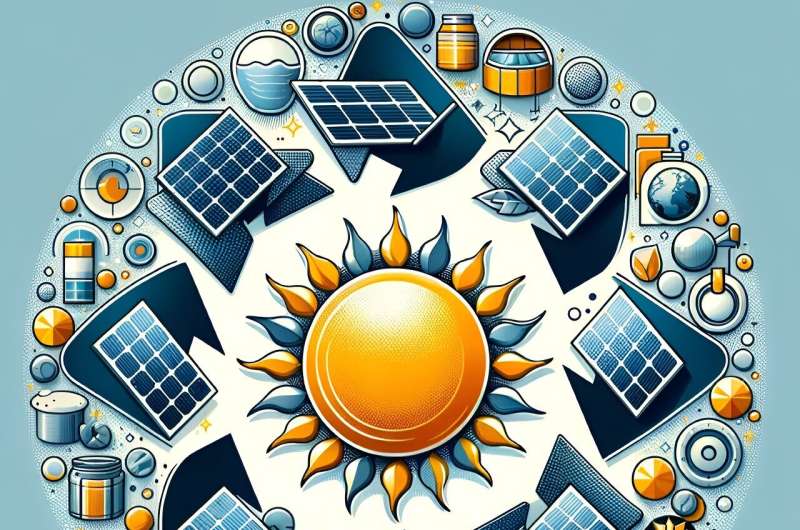This article has been reviewed according to Science X's editorial process and policies. Editors have highlighted the following attributes while ensuring the content's credibility:
fact-checked
trusted source
proofread
The consequences of the PV boom: Study analyzes recycling strategies for solar modules

The energy transition is progressing, and photovoltaics (PV) is playing a key role in this. Enormous capacities are to be added over the next few decades. Experts expect several tens of terawatts by the middle of the century. That's 10 to 25 solar modules for every person. The boom will provide clean, green energy. But this growth also has its downsides.
Several million tons of waste from old modules are expected by 2050—and that's just for the European market. Even if today's PV modules are designed to last as long as possible, they will end up in landfill at the end of their life, and with them some valuable materials.
"Circular economy recycling in photovoltaics will be crucial to avoiding waste streams on a scale roughly equivalent to today's global electronic waste," explains physicist Dr. Marius Peters from the Helmholtz Institute Erlangen-Nürnberg for Renewable Energies (HI ERN), a branch of Forschungszentrum Jülich.
Today's solar modules are only suitable for this to a limited extent. The reason for this is the integrated—i.e., hardly separable—structure of the modules, which is a prerequisite for their long service life. Even though recycling is mandatory in the European Union, PV modules are, therefore, difficult to reuse in a circular way.
The current study by Dr. Ian Marius Peters, Dr. Jens Hauch, and Prof Christoph Brabec from HI ERN shows how important it is for the rapid growth of the PV industry to recycle these materials. "Our vision is to move away from a design for eternity towards a design for the eternal cycle," says Peters "This will make renewable energy more sustainable than any energy technology before."
Not for eternity but for an eternal cycle
The most suitable market to absorb the amount of recycled material will, therefore, be the production of PV modules themselves. Only in this sector is the demand large enough in some cases. "Even without circular recycling, solar energy is sustainable," says Peters.
"However, circular recycling offers the opportunity to establish a genuine circular economy and become a pioneer of a culture of sustainability here too."
But how can recycling really become circular? The HI ERN study points the way to a more sustainable and economically viable future for the PV industry: The first step is to design solar modules for the eternal cycle. The materials used must be easier and cleaner to separate.
The materials used must also be better documented and characterized. Ultimately, the success of recycling will depend to a large extent on how economically it can be realized.
Circular resource management of different materials
There is actually no shortage of materials. Sufficient resources are available for the enormous expansion of photovoltaics. However, the quantities required are enormous. Good material management is, therefore, advantageous for rapid expansion.
Glass, for example, accounts for up to 75% of the mass of a solar module. Solar glass can be recovered using established processes, but only in poor quality, so it is not available for the production of new modules. This is not a problem with the small quantity of modules that are recycled today. However, this is likely to change from the mid to late 2030s, when millions of tons of used solar glass will be produced every year.
"No application needs this amount of old glass. Circular recycling is the only way to prevent this glass from ending up as waste," explains Peters. Circular utilization also strengthens the economic position of the solar industry.
Another example is the use of certain polymers that compete with the shoe industry, among others. The existing production capacities here are limited. Through circular recycling, capacities can be expanded more quickly, and bottlenecks in production can be avoided. Circular recycling also enables the recovery of valuable materials.
The solar industry already accounted for 12.7% of annual silver production in 2020. Future modules will and must be managed without silver. But until then, thousands of tons of silver will be used in modules. Circular recycling makes it possible to recover this treasure and make it available. Silver is used in many different ways; its availability is limited, and it is therefore a precious resource.
More information: Ian Marius Peters et al, Cradle-to-cradle recycling in terawatt photovoltaics: A vision of perpetual utility, Joule (2024). DOI: 10.1016/j.joule.2024.01.025


















